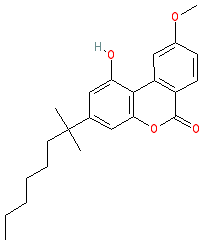GtoPdb is requesting financial support from commercial users. Please see our sustainability page for more information.
|
Synonyms: AM-1710 | analog 4b [PMID: 18038967]
Compound class:
Synthetic organic
Comment: AM1710 is a cannabilactone class, selective cannabinoid CB2 receptor agonist [5]. The cannabilactones produce peripheral analgesic activity without the the psychoactive central nervous system side-effects of other CB2 receptor agonists [3]. As expected from its pharmacological profile, AM1710 shows limited blood brain barrier penetration [5]. It has potent agonist activity at rat and mouse CB2 receptors but much reduced activity at human receptors, so is an excellent tool for rodent studies, but it is less useful for translation-to-human studies. In vitro experiments have identified low-potency CB1 inverse agonist activity, but the in vivo relevance of this discovery is undetermined [2].It is important to note that the sequence heterogeneity in CB2 across species leads to different pharmacologic responses to identical drugs [1], so extrapolating results from rodent models to humans should be approached with caution.
A 2019 publication of work by Li et al. describes rodent experiments that they undertook to resolve the mechanism(s) by which AM1710 suppresses allodynia caused by distinct pathological processes [4]. Their investigations show that AM1710 is not a broad-spectrum analgesic. In rodent models it is effective in paclitaxel-induced mechanical and cold allodynia but not in mechanically-induced allodynia. Ligand Activity Visualisation ChartsThese are box plot that provide a unique visualisation, summarising all the activity data for a ligand taken from ChEMBL and GtoPdb across multiple targets and species. Click on a plot to see the median, interquartile range, low and high data points. A value of zero indicates that no data are available. A separate chart is created for each target, and where possible the algorithm tries to merge ChEMBL and GtoPdb targets by matching them on name and UniProt accession, for each available species. However, please note that inconsistency in naming of targets may lead to data for the same target being reported across multiple charts. ✖ |
|
|||||||||||||||||||||||||||||||||||
| References |
|
1. Bingham B, Jones PG, Uveges AJ, Kotnis S, Lu P, Smith VA, Sun SC, Resnick L, Chlenov M, He Y et al.. (2007)
Species-specific in vitro pharmacological effects of the cannabinoid receptor 2 (CB2) selective ligand AM1241 and its resolved enantiomers. Br J Pharmacol, 151 (7): 1061-70. [PMID:17549048] |
|
2. Dhopeshwarkar A, Murataeva N, Makriyannis A, Straiker A, Mackie K. (2017)
Two Janus Cannabinoids That Are Both CB2 Agonists and CB1 Antagonists. J Pharmacol Exp Ther, 360 (2): 300-311. [PMID:27927913] |
|
3. Khanolkar AD, Lu D, Ibrahim M, Duclos Jr RI, Thakur GA, Malan Jr TP, Porreca F, Veerappan V, Tian X, George C et al.. (2007)
Cannabilactones: a novel class of CB2 selective agonists with peripheral analgesic activity. J Med Chem, 50 (26): 6493-500. [PMID:18038967] |
|
4. Li AL, Lin X, Dhopeshwarkar AS, Thomaz AC, Carey LM, Liu Y, Nikas SP, Makriyannis A, Mackie K, Hohmann AG. (2019)
Cannabinoid CB2 Agonist AM1710 Differentially Suppresses Distinct Pathological Pain States and Attenuates Morphine Tolerance and Withdrawal. Mol Pharmacol, 95 (2): 155-168. [PMID:30504240] |
|
5. Rahn EJ, Thakur GA, Wood JA, Zvonok AM, Makriyannis A, Hohmann AG. (2011)
Pharmacological characterization of AM1710, a putative cannabinoid CB2 agonist from the cannabilactone class: antinociception without central nervous system side-effects. Pharmacol Biochem Behav, 98 (4): 493-502. [PMID:21382397] |







